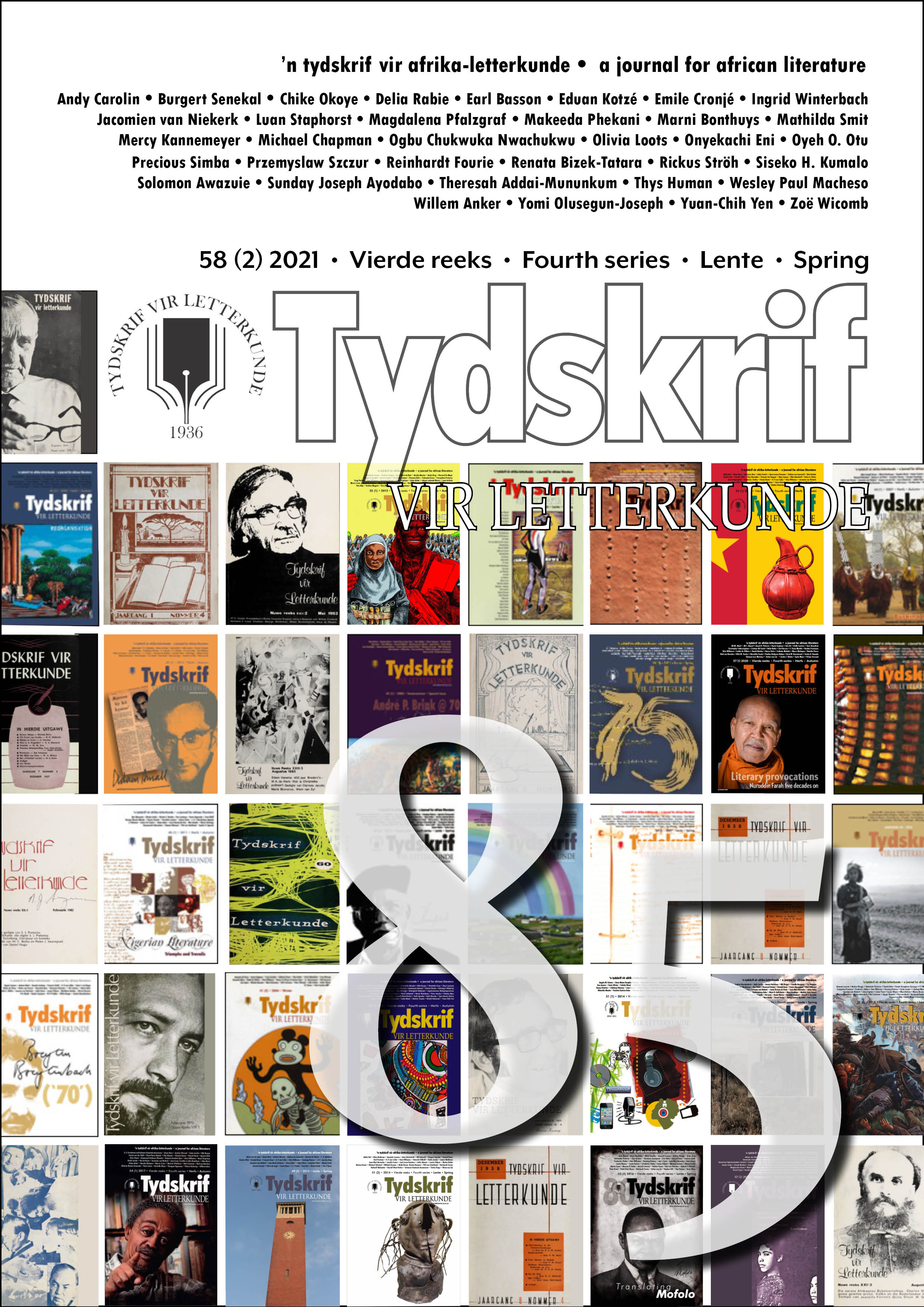Flânerie in Valerie Tagwira’s The Uncertainty of Hope
DOI:
https://doi.org/10.17159/tl.v58i2.8403Keywords:
Zimbabwean literature, Valerie Tagwira, mobility, flânerie, urban walking, modernity, genderAbstract
Valerie Tagwira’s debut novel The Uncertainty of Hope, set in Harare in 2005, depicts the city on the brink of collapse, characterized by the effects of economic crisis and political violence against the urban poor. Political marginalization of the working classes and gender-based violence intersect and diminish the prospects for the social and spatial mobility of the urban poor. In this article I apply the lens of flânerie to the pedestrian movements of Tagwira’s protagonist Onai Moyo, an impoverished woman who makes a living by selling vegetables on Harare’s streets. In order to make a case for Onai’s ‘flânerie against all odds’, I revisit Walter Benjamin’s theorization as well as recent scholarly engagements with flânerie in non-European settings. By giving her protagonist a gaze traditionally associated with a European middle-class urbanity of the 19th century, Tagwira expands a tradition of city writing/walking and, like other contemporary engagements with flânerie, also breathes new life into a concept often pronounced inappropriate or unproductive for readings of non-European literature.
Downloads
References
Baudelaire, Charles. “The Painter of Modern Life.” The Painter of Modern Life and Other Essays, edited and translated by Jonathan Mayne. Phaïdon, 1965, pp. 1–34.
Bauman, Zygmunt. City of Fears, City of Hopes. Goldsmiths College; U of London; Center for Urban and Community Research, 2003.
Benjamin, Walter. The Arcades Project, translated by Howard Eiland & Kevin McLaughlin, edited by Rolf Tiedemann. Harvard U P, 2002.
Benjamin, Walter. “The Paris of the Second Empire in Baudelaire,” translated by Harry Zohn. The Writer of Modern Life: Essays on Charles Baudelaire, edited by Michael William Jennings. Harvard U P, 2006, pp. 46–134.
Berman, Marshall. All That is Solid Melts into Air. The Experience of Modernity. Simon & Schuster, 1982.
Burger, Bibi. “Kleinboer as Johannesburgse Flaneur, met Spesifieke Verwysing na Werfsonde.” Journal of Literary Studies vol. 34, no. 1, 2018, pp. 38–60. DOI: https://doi.org/10.1080/02564718.2018.1447868.
Chitando, Anna. “Portrait of Courage: Women and Survival in Tagwira’s The Uncertainty of Hope.” Journal for Studies in Humanities and Social Sciences vol. 4, no. 1&2, 2015, pp. 216–24.
Christiansen, Lene Bull. “‘Respectable Women’ versus ‘Small Houses’. Feminist Negotiations of Sexual Morality, Marriage and the Challenge of HIV/AIDS in Zimbabwe.” Journal of Southern African Studies vol. 39, no. 3, 2013, pp. 511–26. DOI: https://doi.org/10.1080/03057070.2013.826069.
Cole, Teju. Open City: A Novel. Faber & Faber, 2012.
De Certeau, Michel. “Walking in the City.” The Practice of Everyday Life, translated by Steven Rendall. Vol. 1. U of California P, 2011, pp. 91–110.
Fox, Patricia. “Not Your Grandparents’ Flâneur: The Afropolitan Detective in the Urban Crime Novels of Quartey and Crompton.” Africa Today vol. 65, no. 4, 2019, pp. 61–81. DOI: https://doi.org/10.2979/africatoday.65.4.05.
Hartwiger, Alexander Greer. “The Postcolonial Flâneur: Open City and the Urban Palimpsest.” Postcolonial Text vol. 11, no. 1, 2016, pp. 2–17.
Mpofu, Busani. “Operation ‘Live Well’ or ‘Cry Well’? An Analysis of the ‘Rebuilding’ Programme in Bulawayo, Zimbabwe.” Journal of Southern African Studies vol. 37, no. 1, 2011, pp. 177–92. DOI: https://doi.org/10.1080/03057070.2011.554211.
Muchemwa, Kizito. “Imagining the City in Zimbabwean Literature 1949 to 2009.” Diss. Stellenbosch U, 2013. http://hdl.handle.net/10019.1/85579.
Muchemwa, Kizito. “Old and New Fictions: Rearranging the Geographies of Urban Space and Identities in Post-2006 Zimbabwean Fiction.” English Academy Review vol. 27, no. 2, 2010, pp. 134–45.
Musanga, Terrence. “Intra-Urban Mobilities and the Depiction of the City in Zimbabwean Fiction as Reflected in Valerie Tagwira’s Uncertainty of Hope (2006).” Journal of Black Studies vol. 46, no. 1, 2015, pp. 102–16. DOI: https://doi.org/10.1177/0021934714558295.
Ncube, Gibson. “Of Dirt, Disinfection and Purgation: Discursive Construction of State Violence in Selected Contemporary Zimbabwean Literature.” Tydskrif vir Letterkunde vol. 55, no. 1, 2018, pp. 41–53. DOI: https://doi.org/10.17159/2309-9070/tvl.v.55i1.1548.
Ndjio, Basile. “Douala: Inventing Life in an African Necropolis.” Cities in Contemporary Africa, edited by Martin J. Murray & Garth Andrew Myers. Palgrave Macmillan, 2011, pp. 103–25. DOI: https://doi.org/10.1057/9780230603349_5.
Nuttall, Sarah & Achille Mbembe. “Afropolis: From Johannesburg.” PMLA vol. 122, no. 1, 2007, pp. 281–288. DOI: https://doi.org/10.1632/pmla.2007.122.1.281.
Nyambi, Oliver. “The ‘New’ Woman: Changing Zimbabwean Female Identities in Valerie Tagwira’s novel The Uncertainty of Hope.” English Academy Review vol. 31, no. 1, 2014, pp. 38–50. DOI: https://doi.org/10.1080/10131752.2014.909002.
Nyambi, Oliver & Tendai Mangena. “Food, Gender and the Crisis in Zimbabwe: An Approach to Virginia Phiri’s Highway Queen and Valerie Tagwira’s the Uncertainty of Hope.” Critique: Studies in Contemporary Fiction vol. 3, no. 1, 2020, pp. 1–13. DOI: https://doi.org/10.1080/00111619.2020.1729088.
Ortega, Kirsten Bartholomew. “The Black Flâneuse: Gwendolyn Brooks’s ‘In the Mecca’.” Journal of Modern Literature vol. 30, no. 4, 2007, pp. 139–55.
Pfalzgraf, Magdalena. Mobility in Contemporary Zimbabwean Literature in English: Crossing Borders, Transcending Boundaries. Routledge, 2021. DOI: https://doi.org/10.4324/9781003146070.
Potts, Deborah. “‘Restoring Order’? Operation Murambatsvina and the Urban Crisis in Zimbabwe.” Journal of Southern African Studies vol. 32, no. 2, 2006, pp. 273–91. DOI: https://doi.org/10.1080/03057070600656200.
Sandwith, Corinne. “Reading and Roaming the Racial City: R. R. R. Dhlomo and The Bantu World.” English in Africa vol. 45, no. 3, 2019, pp. 17–39. DOI: https://doi.org/10.4314/eia.v45i3.2.
Schulze-Engler, Frank. “Fragile Modernities: History and Historiography in Contemporary African Fiction.” Postcolonial Studies Across the Disciplines, edited by Jana Gohrisch & Ellen Grünkemeier. Rodopi, 2013, pp. 263–82. DOI: https://doi.org/10.1163/9789401210027_015.
Simone, AbdouMaliq. “The Urbanity of Movement: Dynamic Frontiers in Contemporary Africa.” Journal of Planning Education and Research vol. 31, no. 4, 2011, pp. 1–13.
Tagwira, Valerie. The Uncertainty of Hope. Weaver, 2006.
Varvogli, Aliki. “Urban Mobility and Race: Dinaw Mengestu’s The Beautiful Things That Heaven Bears and Teju Cole’s Open City.” Studies in American Fiction vol. 44, no. 2, 2017, pp. 235–57. DOI: https://doi.org/10.1353/saf.2017.0010.
Vermeulen, Pieter. “Flights of Memory: Teju Cole’s Open City and the Limits of Aesthetic Cosmopolitanism.” Journal of Modern Literature vol. 37, no. 1, 2013, pp. 40–56. https://doi.org/10.2979/jmodelite.37.1.40.
Wolff, Janet. “The Invisible Flâneuse. Women and the Literature of Modernity.” Theory, Culture & Society vol. 2, no. 3, 1985, pp. 37–46. https://doi.org/10.1177/0263276485002003005.
Published
Issue
Section
License
Copyright (c) 2021 Tydskrif vir Letterkunde

This work is licensed under a Creative Commons Attribution-ShareAlike 4.0 International License.


 https://orcid.org/0000-0001-6465-6584
https://orcid.org/0000-0001-6465-6584


.png)